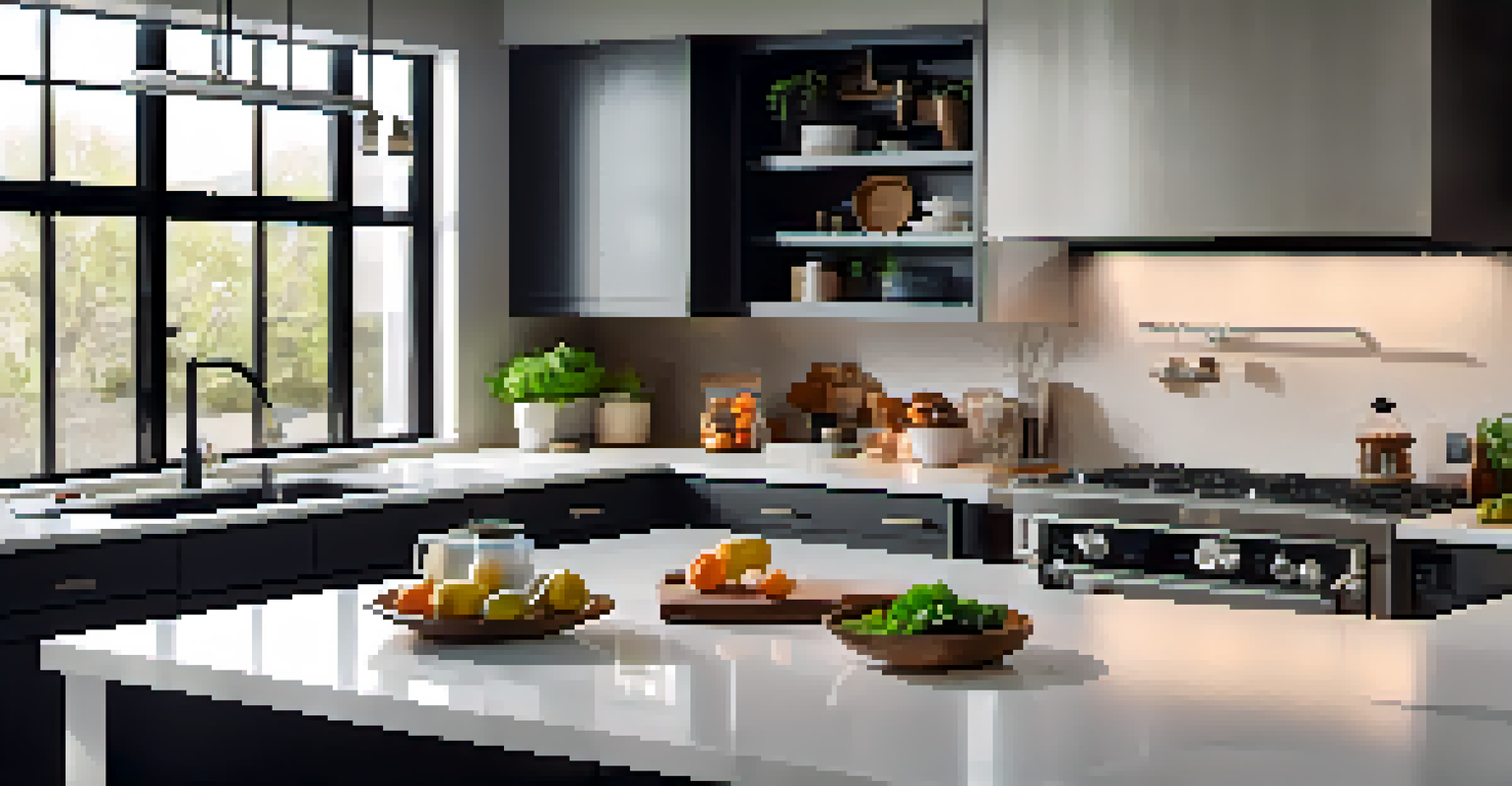Integrating Smart Home Devices for Maximum Value

Understanding Smart Home Devices and Their Benefits
Smart home devices are technology-powered gadgets designed to improve the comfort, security, and efficiency of our living spaces. They range from smart thermostats to automated lighting systems, and they can all work together to create a seamless home experience. By integrating these devices, homeowners can enjoy increased convenience and energy savings, making their lives easier and more enjoyable.
Technology is best when it brings people together.
One of the standout benefits of smart home devices is their ability to communicate with each other. For instance, a smart thermostat can adjust the temperature based on data from smart sensors detecting when you are home or away. This level of coordination not only enhances comfort but can also lead to significant energy savings, translating into lower utility bills over time.
Moreover, many smart home devices come with mobile apps that allow you to control them from anywhere. This means you can adjust your home settings while at work or on vacation, giving you peace of mind and a sense of control over your living environment. With the right integration, your home can become a responsive, adaptive ecosystem tailored to your lifestyle.
Choosing the Right Smart Home Ecosystem
When it comes to integrating smart home devices, choosing the right ecosystem is crucial. Popular ecosystems like Amazon Alexa, Google Assistant, and Apple HomeKit each offer unique features and compatible devices, making it essential to pick one that aligns with your needs. For example, if you already own numerous Alexa devices, it makes sense to continue expanding within that ecosystem for optimal compatibility.

Additionally, consider the user interface and ease of use. Some ecosystems are more intuitive than others, and you want to ensure that all family members can easily navigate the system. A user-friendly interface can make the integration process less daunting and more enjoyable for everyone involved.
Smart Devices Enhance Home Comfort
Integrating smart home devices boosts comfort and efficiency, allowing homeowners to control their environment effortlessly.
Lastly, think about future scalability. You may start with a few devices today, but as your needs and preferences evolve, you may want to add more. Choosing an ecosystem that allows for easy integration of additional devices can save you time and hassle down the road.
Creating a Smart Home Hub for Centralized Control
A smart home hub acts as the central command center for all your devices, allowing them to communicate with each other and be controlled from a single interface. This can greatly simplify your smart home setup, making it easier to manage multiple devices. For instance, you can use a hub to create routines, such as turning off all the lights and adjusting the thermostat with a single command when you leave for work.
The greatest danger in times of turbulence is not the turbulence; it is to act with yesterday's logic.
Many hubs also support automation features that enable your devices to work together seamlessly. For example, your smart lights can automatically turn on when your smart door lock is unlocked, creating a welcoming atmosphere as you arrive home. This level of integration not only enhances convenience but also adds a layer of security to your home.
Choosing the right hub depends on the devices you own and the ecosystem you’ve selected. Some hubs are more versatile and support a broader range of devices, while others are tailored to specific brands. Researching compatibility is key to ensuring that your hub can manage all your smart home gadgets effectively.
Implementing Smart Security Solutions
Security is one of the most compelling reasons to integrate smart home devices. By incorporating smart locks, cameras, and alarm systems, you can monitor and control your home’s security from anywhere. For instance, smart doorbells allow you to see and speak to visitors remotely, giving you peace of mind when you're not at home.
Additionally, many security devices can work together to create a comprehensive system. For example, if a motion detector senses movement while you’re away, it can trigger your security camera to start recording and send you an alert. This level of integration enhances the effectiveness of your security measures and allows for a rapid response to potential threats.
Security Solutions Offer Peace of Mind
Smart security devices provide remote monitoring and alerts, significantly enhancing the safety of your home.
Moreover, the ability to remotely monitor your security system can deter intruders and enhance your overall sense of safety. Knowing you can check your cameras or lock your doors from your smartphone can provide a significant psychological benefit, making your home feel more secure.
Enhancing Energy Efficiency with Smart Devices
Energy efficiency is another significant advantage of integrating smart home devices. Smart thermostats, for instance, can learn your schedule and adjust heating and cooling based on when you're home or away. This not only keeps your home comfortable but can also lead to substantial energy savings over time.
Smart lighting systems can also contribute to energy efficiency by allowing you to control lights remotely or set schedules for when they should be on or off. For example, you can program your lights to turn off when you leave for work, ensuring that you’re not wasting electricity. Additionally, using energy-efficient smart bulbs can further enhance these savings.
By monitoring energy usage through smart plugs or energy management systems, you can gain insights into which devices consume the most power. This data allows you to make informed decisions about your energy consumption, ultimately reducing your carbon footprint and saving on utility costs.
Automating Daily Routines for Seamless Living
One of the most enjoyable aspects of integrating smart home devices is the ability to automate daily routines. Imagine waking up to soft lighting gradually brightening and your coffee brewing automatically. These small but impactful changes can transform your mornings from chaotic to serene.
With smart assistants, you can set up routines that trigger multiple actions with a single command. For example, saying, 'Goodnight' could lock your doors, turn off your lights, and adjust the thermostat to a comfortable sleeping temperature. This not only saves time but also instills a sense of security as you prepare for rest.
Energy Efficiency Saves Costs
Utilizing smart devices like thermostats and lighting systems leads to substantial energy savings and reduced utility bills.
Automation can extend beyond mornings and nights. Consider setting your smart devices to create a cozy atmosphere for movie nights, dimming lights and adjusting the thermostat with just a voice command. This level of control allows you to tailor your home environment to your lifestyle effortlessly.
Staying Updated with the Latest Technology Trends
The world of smart home technology is constantly evolving, with new devices and features emerging regularly. To maximize the value of your integrated system, it’s essential to stay informed about the latest trends and advancements in the market. Following tech blogs or subscribing to newsletters can help you keep your finger on the pulse of smart home innovations.
Moreover, many manufacturers release software updates that enhance functionality or add new features to existing devices. Regularly checking for updates ensures that your smart home continues to perform at its best and can even introduce new capabilities you might find beneficial.

Lastly, consider participating in online communities or forums where smart home enthusiasts share tips and experiences. These platforms can provide valuable insights into the best practices for integration and offer suggestions on new devices that could enhance your setup.